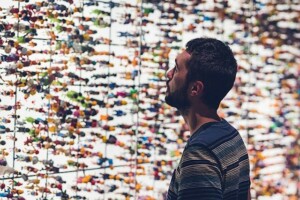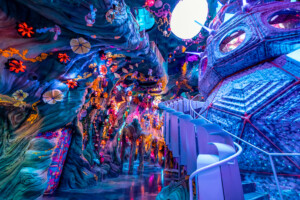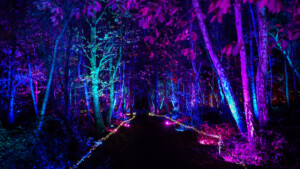Ben Tripp (below right) is a highly experienced theme park designer, concept designer and art director and has been working in the theme park, destination resort and museum industry for nearly twenty years. Currently working on a variety of projects with Disney about which he cannot speak, he also writes political satire and has just completed a novel about zombies.
 By: Chad Emerson
By: Chad Emerson
Share with us how you first got started working on projects in the amusement industry.
I was a fresh-faced youth on the East Coast, painting houses and doing editorial illustrations, when Disney artist Jeff Schrader happened to visit my father, Wallace Tripp. My old man was a well-known illustrator at the time. There was some work of mine lying around; Jeff saw it and said it looked like something Walt Disney Imagineering would like. I’d never heard of the place, but I was between drywall jobs, so I got in touch with them. WDI moved me to California and I was an Imagineer for six years.
Related: Building on Ideas with Theme Park Architect Bruce Green / Theme Park & Museum Design with Larry Wyatt / Mark Nichols – a Career in Attractions and Theatrical Design / The Creature from the Black Lagoon returns, in a new attraction at Universal Studios Theme Park Hollywood
What have been some of the most rewarding projects you’ve worked on and why?
One of my very favorite projects is Disney’s Animal Kingdom. I was lucky enough to end up as lead designer on the Kilimanjaro Safaris and its associated Africa-themed areas, alongside the brilliant landscape designer John Shields. As an opportunity to promote conservation, that park is almost without peer in the world; in addition, it’s home to many severely endangered animals, and is a sort of ark in that respect. We did everything we could to provide each species with habitats that didn’t just look like the real thing, but allowed the animals to behave as they would in the wild. Human guests love it, too, which is nice — but gorillas make the best clients.
A number of my favorite projects haven’t even been theme parks, but use the same design methods and placemaking approaches to great effect — especially urba n developments, in which there are residential, work, educational, retail, and entertainment components; together these create a lifestyle proposition that is energized by the people who inhabit them. This has been an important outgrowth of themed design overlapping with public architecture. It’s extremely difficult in some ways, because you have no control over how the place will evolve and how people will use it, but the reward is bringing what’s best about theme parks to enrich people’s real, everyday lives.
n developments, in which there are residential, work, educational, retail, and entertainment components; together these create a lifestyle proposition that is energized by the people who inhabit them. This has been an important outgrowth of themed design overlapping with public architecture. It’s extremely difficult in some ways, because you have no control over how the place will evolve and how people will use it, but the reward is bringing what’s best about theme parks to enrich people’s real, everyday lives.
Sony’s Metreon Center in San Francisco was a fascinating retail/entertainment project along these lines, and I had the once-in-a-lifetime chance to work on projects in Berlin after the Wall came down, when there was suddenly all this wide-open urban space in the middle of a major city. I’ve done urban development projects all over Asia, India, the Middle East, America, and Europe; the same design principles work no matter where the project is.
What about some of the most challenging ones?
You wouldn’t think it, but museum projects can be extremely challenging. There’s a fine line: you don’t want to curate a bunch of dull artifacts in cases, but you also don’t want to lose the educational content beneath the razzle-dazzle. Somewhere in the middle there’s educational storytelling, and that’s a great deal of fun to do.
Sometimes the challenges are impossible to predict — a while back I was involved in an Asian theme park project which shall go nameless, for reasons that will become obvious. It was a lovely site, richly detailed concept, lots of interesting stuff to do. About a year into the work, the client was abruptly thrown in jail for operating a brothel in the basement of one of his hotels. That was the end of that! It was a nice hotel, though.
In light of the current global economic issues, what do you believe will be some of the key challenges that amusement facilities will face going forward?
This is a huge question. How we approach it determines whether this industry has a future.
Theme park folks aren’t known for our interest in politics or economics — after all, we design places for the express purpose of escaping from real-world worries like that. But everywhere around the world, the middle class — which i s our primary audience, by an overwhelming margin — is under incredible pressure. Unprecedented extraction and concentration of wealth has left the vast majority of people without sufficient disposable income for those big theme park vacations, and even people who have the money are wary of spending it in case they need cash reserves for hard times. If you’re Disney or Universal, you’ll do fine. You’re on the pilgrimage route. But pretty much every other player in the business is in jeopardy.
s our primary audience, by an overwhelming margin — is under incredible pressure. Unprecedented extraction and concentration of wealth has left the vast majority of people without sufficient disposable income for those big theme park vacations, and even people who have the money are wary of spending it in case they need cash reserves for hard times. If you’re Disney or Universal, you’ll do fine. You’re on the pilgrimage route. But pretty much every other player in the business is in jeopardy.
What do we do about that? Well, the big-picture answer is we have to remobilize incomes and raise all boats. That’s outside our design brief, however. As designers and developers, we have two basic routes to follow: first, we can start making specialized, low-volume themed venues intended only for wealthy people. There is work of this type going on, but it’s tough: we’re trying to capture an audience that already has all the wonders of the world at its fingertips. A themed evocation of the African savannah is as close as most folks are going to get to a safari — and they’re happy with that. It’s a lot harder to convince people who can afford a real safari that they should visit a theme park instead.
The second thing we can do is to begin integrating experiential design into people’s everyday lives. This is already happening in urban developments, museums, even restaurants and retail — we are seeing some sophisticated storytelling methodologies at wor k in public spaces, things that were the exclusive province of theme parks ten years ago. And that brings up what might be the shape of the business for the next decade or so: if people can’t afford to go to the parks, we’re going to have to bring the parks to them.
k in public spaces, things that were the exclusive province of theme parks ten years ago. And that brings up what might be the shape of the business for the next decade or so: if people can’t afford to go to the parks, we’re going to have to bring the parks to them.
This is already happening. There are touring museum exhibits, for example, the design and execution of which is competitive with in-park attractions. They’re doing tremendous business. In addition, arena events like Cirque de Soleil, Walking With Dinosaurs, and so forth are thriving. We may be seeing a lot more of these traveling shows and attractions. Beyond that, we could see the resurgence of regional theme parks. A smaller local park doesn’t require plane tickets, car rental, or a week-long hotel stay; maybe it won’t have the biggest roller coaster, but it doesn’t have to.
There are now two generations of expert themed entertainment creators scattered all around the world. They do great work. You don’t have to be one of the majors with in-house design and fabrication departments. Whether you’ve got a neighborhood that needs revitalization, a regional park in need of refreshing, or a great idea for a touring attraction, taking world-class entertainment design local may just be the way of the future.
Share with us how writing a novel was influenced by your amusement industry work—or vice versa.
My first novel, Rise Again, is a zombie apocalypse story — so you wouldn’t think it would have much in common with themed entertainment. But I had a lot of crowd scenes in the book. I’ve spent the last quarter of a century studying crowd behavior. That came in handy!











